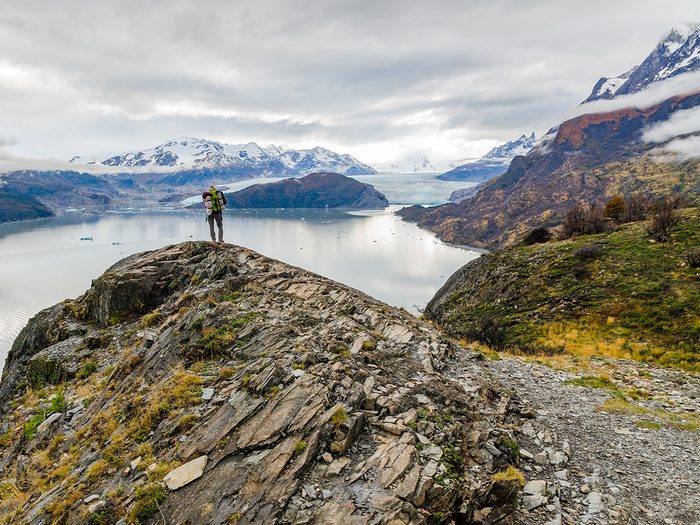
The Best Hikes in the World
Torres del Paine Circuit, Chile
Boasting trademark jagged pink-granite rock thrusts, glaciers and their accompanying bright blue lakes, Torres del Paine National Park will compel you to stop often on its 84-kilometre loop for a photo or just a gasp. Hike all of it in ten days, take five days to trek what’s called the ‘W,’ or just head into the park for day trips to hit the highlights. The highest point in this UNESCO Biosphere is 1,200 metres, so altitude sickness won’t be an issue. But you still get up close to glaciers and can even camp lakeside where the ice is crashing into the water. You’ll find plenty of wildlife, especially birds, guanacos (like llamas), nandu (ostrich lite), and if you’re lucky, a puma. This is Patagonia at its most awesome, and one of the best hikes in the world.
When to go: If you like more hiking time in a day, best to go during December-January when the sunset isn’t until 10 p.m. During that time and through March is the warmest season with low chance of rain.
Difficulty: The trail covers all skill levels. Some paths may be strenuous but generally unintimidating. You don’t necessarily need a guide either.
Things to know: You can check in at a local hostel near the park entrance or just pitch a tent. If you’ve got the money, one of the adventure lodges, such as La Remota with upscale pampering and daily expert guides, is a nice way to go too.
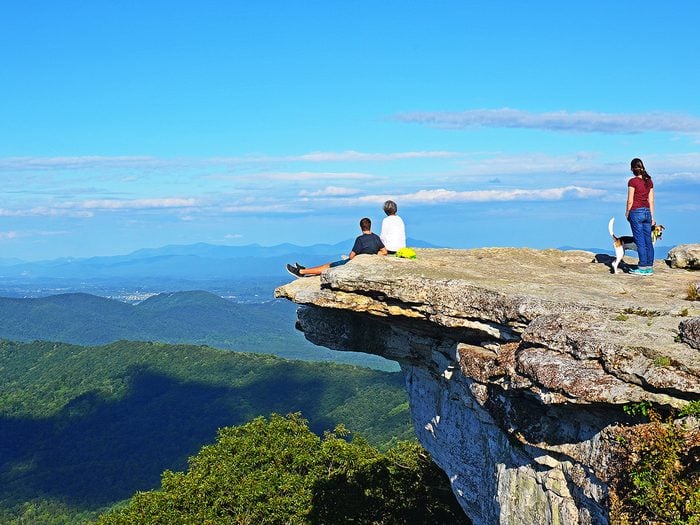
Appalachian Trail, USA
Bill Bryson gave the benign title A Walk in the Woods to his book of trekking this enormous trail, one of the best hikes in the world. It’s hard to believe you’re still in the Eastern United States when you’re passing through what is almost exclusively wilderness for 3,500 kilometres. While there are many access points along the Appalachian Trail, making it perfect for day hikes or simple overnighters, the experience is definitely one of leaving civilization behind. The route follows the Appalachian Mountains, only leaving the wild in a few places along the trail’s length, from Georgia in the south all the way north to Maine. Some truly adventurous souls have been known to tackle the entire journey in a summer season.
When to go: The best times are in the spring and fall. If you are attempting to hike its entirety (more than 9,000 hikers have done it), then consider starting in the north to have a bit more warm weather as you near the end—about 6 months after your start!
Difficulty: Some stretches are flat and easy, others are the up-and-down variety that gets your heart pumping. Still others might get your hands involved. Consult guidebooks and websites to make sure you know which variety you’re going to get.
Things to know: Certain sections of the trail can be rather “crowded”. Other stretches might be muddy during rainy periods or just overwhelmed with mosquitoes. Check your target trail section at the Appalachian Trail Conservancy.
Don’t miss our roundup of the best bike trails across Canada.
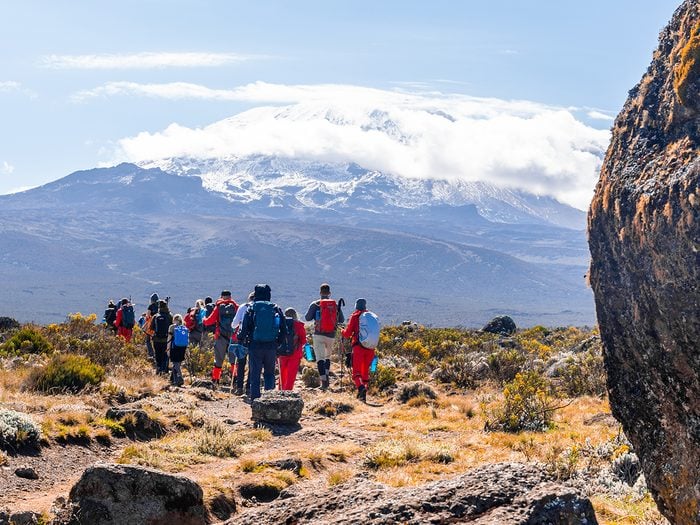
Mount Kilimanjaro to Marangu
Towering to 5,895 metres, Mount Kilimanjaro is Africa’s tallest peak and top of the wish list for hikers visiting the continent. At least five days of hiking will take you to the rooftop of Africa for the best view in Tanzania. The trek starts with rainforest, enters the plateau region and then gets tough as it gains serious altitude for the final stretch through the snow and glaciers at the top.
When to go: Avoid March through May as that is the rainy season. Otherwise, expect cool temperatures on the slopes throughout the year, but hot days near the start/finish line. Weekends bring the most hikers who arrive on Saturday for a Sunday climb.
Difficulty: This is a strenuous hike with some risks from weather and wildlife, but also from Acute Mountain Sickness (altitude sickness).
Things to know: The most popular path is the Marangu Route where you are going to find more fellow travellers. Other options are the Umbwe, Londorossi and Machame Routes. Altitude sickness can be an issue, and while not being alarmist, it should be said that it can be fatal if not taken seriously. Guides are required.
Here are 10 destinations to visit before they disappear.
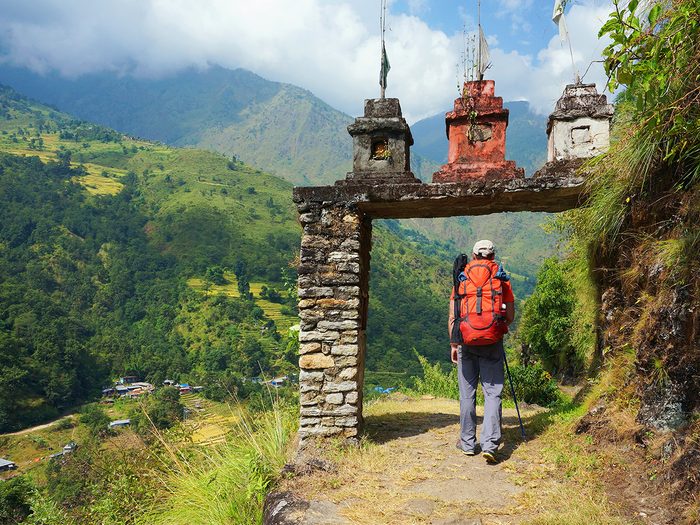
Annapurna Circuit, Nepal
Shaped like a horseshoe, this 206-kilometre trek makes a circle tour of Nepal’s Annapurna range. Terraced rice paddies, jungle, pines, deep canyons, flowing water, and of course the glorious snow-capped peaks themselves make a constantly evolving scenic backdrop on one of the best hikes in the world. But then add to that the people you meet along the way, the teahouses-cum-hostels, yak cheese, the yak-butter candles at night… This is a whole world in itself in a setting that will leave you talking about it for the rest of your days.
When to go: October is best for milder temperatures and clear blue skies.
Difficulty: The climb is gradual and the trail is good, but it takes about 3 weeks to complete the circuit and the highest points are over 5,000 metres.
Things to know: You must have a trail permit, easily purchased in Kathmandu. Teahouses are spread out on the trail making accommodations and food pretty easy.
Check out the world’s most breathtaking forgotten cities.
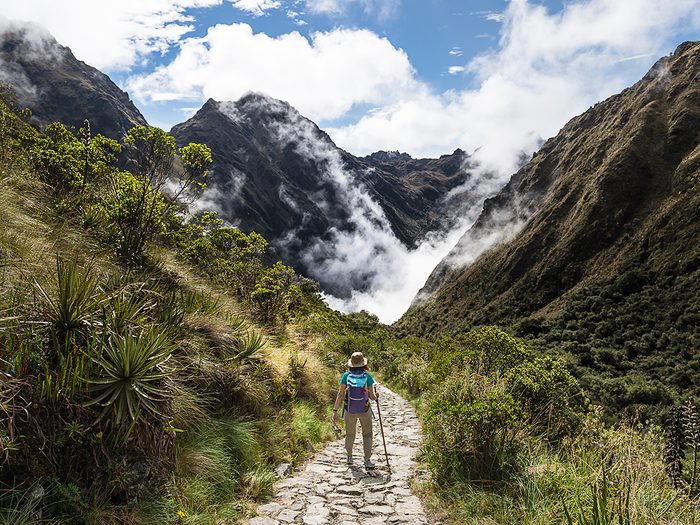
The Inca Trail, Peru
High up in the Andes, Machu Picchu is as mythical a place as you are bound to find. What better way to approach it than by a trek through the mountains? On the Inca Trail, you’ll disappear into the cloud forests, cross valleys and ridges, and stop at archaeological sites along the way. Time the final stretch segment so that you arrive at Machu Picchu for sunrise. And the hike is still not over at that point: climb Huayna Picchu, the green peak in the centre of that typical photo angle of the ruins. Far below you will hear the Urubamba River as it curls around the base of the mountain.
When to go: April to October is best to avoid the rains.
Difficulty: More than a walk in the park, but less than an alpine climb. If you are in half-decent shape, this four-day trek will be fine. Wear good boots; it’s tough on the ankles at some points.
Things to know: The trail goes higher than 4,000 metres so you should spend a bit of time in Cusco to adjust and avoid getting altitude sickness on the trail. Be sure to use an authorized, professional guide. The trail and Machu Picchu itself have entrance fees. Hiking packages should include this in the price as well as your return ticket to Cusco on the train. Get that trail pass well in advance because the number of hikers per day is controlled.
Find out more fantastic things to do in Peru (besides Machu Picchu).
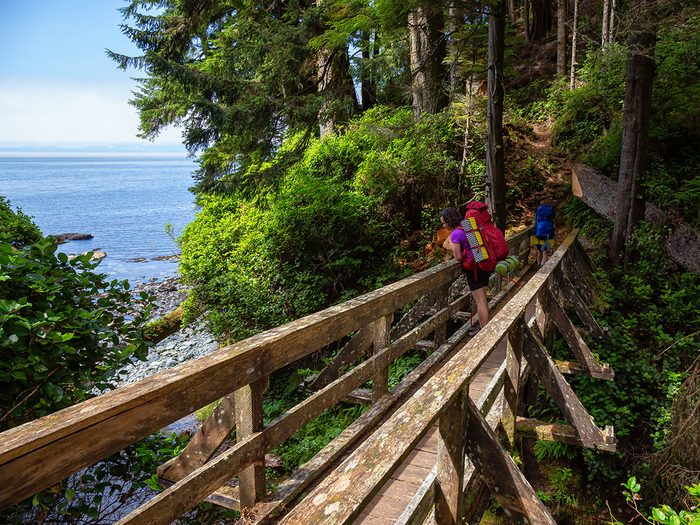
West Coast Trail, Vancouver Island, B.C., Canada
Caves, coves and cliffs dot the shore along the coastal portions of the legendary West Coast Trail. You may encounter sea lions or spot whales offshore, but what you are not likely to see are other hikers. With abundant wildlife (both in the sea and on land) and old-growth forest, this is perfect, pristine Canadian wilderness that is still not too far from civilization. Hop across logs and boulders, get your feet wet in creeks and tide pools, and trek across beautiful beaches and through misty forests. Cable cars, ladders and some rope work add to the adventure. (Here are more essential experiences on the west coast of Canada.)
When to go: The trail is only open from May through September. July and August are peak season so apply early for a trail pass.
Difficulty: Challenging just for the variety of terrain. You can expect to get wet, cold and damp at any time.
Things to know: A limited number of hikers are allowed to set off each day and the required trail permit can be denied at times.
Discover more of Canada’s best hiking trails.
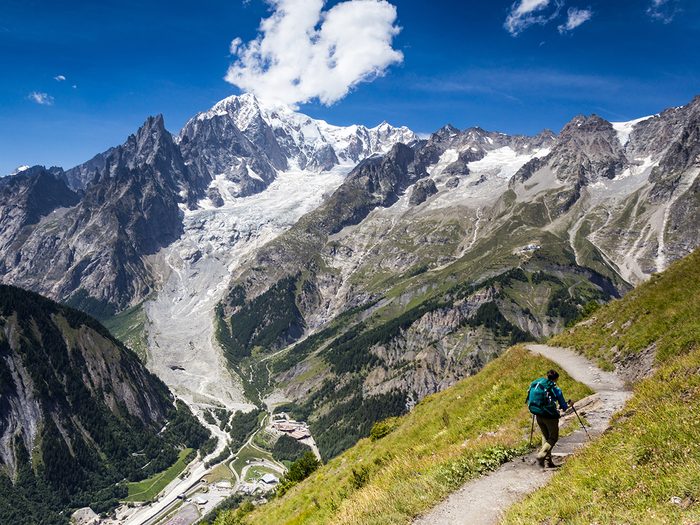
Mont Blanc, France, Italy and Switzerland
Go alpine on this trek around the highest point in Western Europe. The namesake towers to 4,807 metres and is surrounded by other white peaks and glaciers. Stay in huts each night as you make a two-week circle of 170 kilometres through the Alps of three European countries. We’re talking fabulous scenery of green meadows and valleys, blue glaciers and white peaks, with great food and creature comforts when you quit for the day.
When to go: Take advantage of the European summer from June through September.
Difficulty: All levels at one point or another, from easy meadows to strenuous climbs.
Things to know: Book your accommodations along the trail in advance, especially in late July and August when it’s high season. You can camp if you prefer not to hostel it. Rain is likely, especially on any given afternoon. There is some ladder climbing involved, and for those looking to ease the challenge a bit, some cable cars and chair lifts. Get a guide or a tour unless you are really experienced.
Travelling via Paris? Here’s why you need to add the quartier of Le Marais to your itinerary.
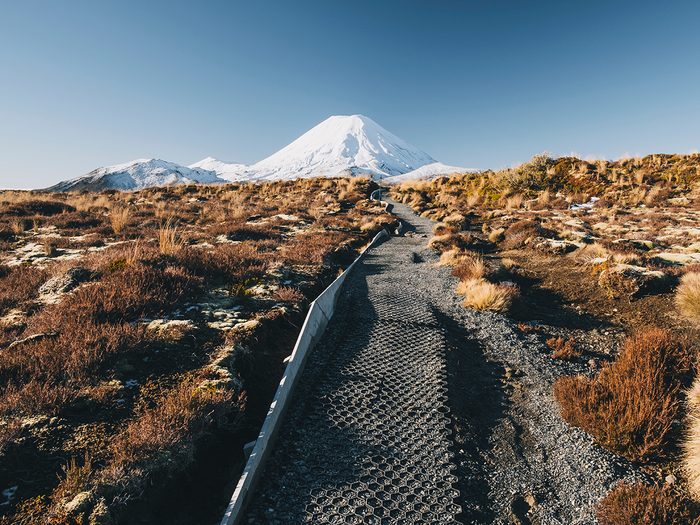
Tongariro Northern Circuit, New Zealand
There are three volcanoes in the centre of New Zealand’s North Island, and the Tongariro Northern Circuit trail takes you around one of them: Mt. Ngauruhoe (above). But the scenery here is much more than just the mountains. You’ll trek through volcanic desert, grassy plain and rich forest, and take in sights like the Red Crater, Emerald Lakes (shown here) and even a bit of boiling mud. The highest point is 1,886 metres and the loop extends for 34 kilometres.
When to go: December through March.
Difficulty: The climbs aren’t too demanding, but you’ll still be facing a medium-level challenge, and there are some tough stretches. The trail is clearly marked so a guide isn’t necessary.
Things to know: It’s popular so you won’t be alone—for better or worse. While the loop can be done in three days you can add on some ascents of Mount Tongariro and Mount Ngauruhoe, which rose to fame as the filming location for Mount Doom from The Lord of the Rings trilogy. A trail pass from the visitor centre is required.
Before you go, get to know one of New Zealand’s quirkiest endangered species: the kiwi bird.
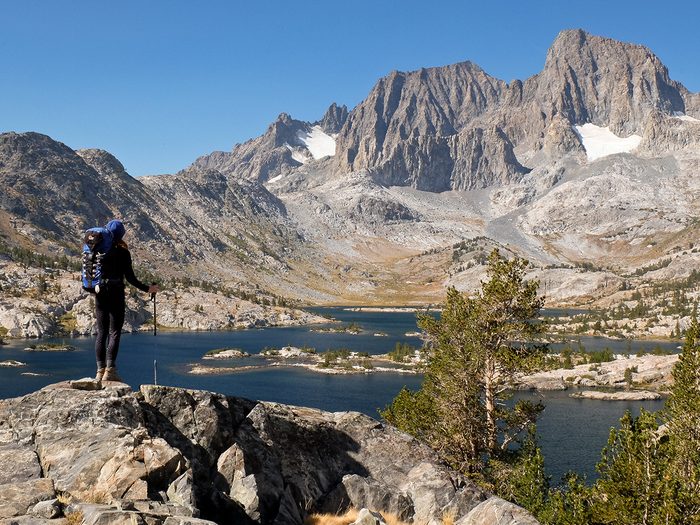
John Muir Trail, Sierra Nevada Range, California, USA
John Muir is an icon to nature lovers, and though he gave his name to this trail, this is also Ansel Adams territory. If that creates some expectations, you can bet you’re going to be satisfied. Count Yosemite and Half Dome among the attractions as well as the sequoias and Mt. Whitney, the tallest peak in the continental United States. The trail passes through six ecological zones and 11 high passes.
When to go: August and September are best. Snow lasts well into summer in the upper reaches.
Difficulty: Moderate to strenuous with Half Dome being something for the more experienced.
Things to know: You need to protect your food from bears, for one thing. You also need a trail permit which you can order in advance, the sooner the better. Otherwise it is first-come, first-served for the rest. There are a lot of considerations for this hike, from gear to safety to supplies, and too numerous to list here. Research and plan carefully. Public transportation to trailheads makes it possible to do this challenging hike in segments and reverse the order (descent vs. climb) in some cases.
Looking for adventures even closer to home? Explore all 20 UNESCO World Heritage Sites across Canada.
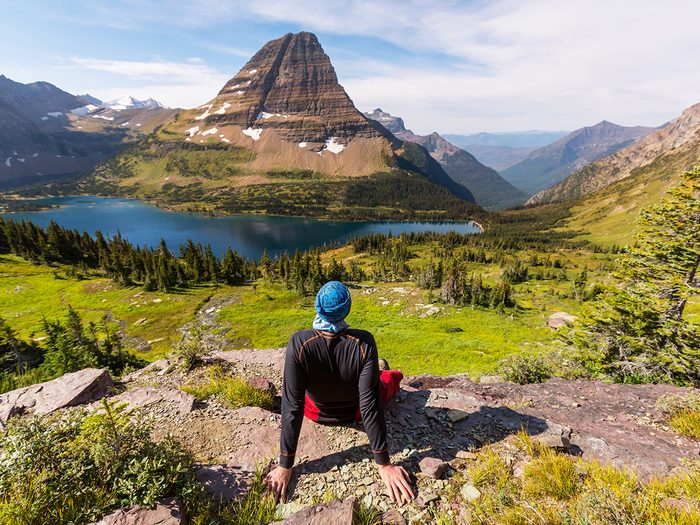
Glacier National Park, Montana, USA
Skirting the U.S. border with Canada in Montana, this mountainous beauty is one of the most important wildlife habitats in the American park system. You’ll be sharing this 104-kilometre hike with the critters, from the little ones (over 200 species of birds) to the not-so-little (elk, moose, bighorn sheep and even black and grizzly bears). If you get there before the middle of August, you will also have the bonus of meadows full of wildflower colours. Pass through the 37-metre Ptarmigan Tunnel and do make a side trip to Iceberg Lake. You can even get to a trailhead by boat from Alberta’s Waterton Lakes National Park. With over 1,100 kilometres of trails in this park, you may want to come back a few more times.
When to go: July through September is the best time.
Difficulty: The hike is moderately challenging, but the trails are well marked.
Things to know: Book that trail pass well in advance. You will also have to book your campsite for each night of the hike. Though the summer temperatures in daytime will be comfortable, it often dips below freezing at night. Also, you are going to want to bone up on your bear knowledge and how to safely avoid and understand them. It’s their park, really. You’re just a guest.
Now that you know the best hikes in the world, find out the 10 national parks every Canadian needs to visit.